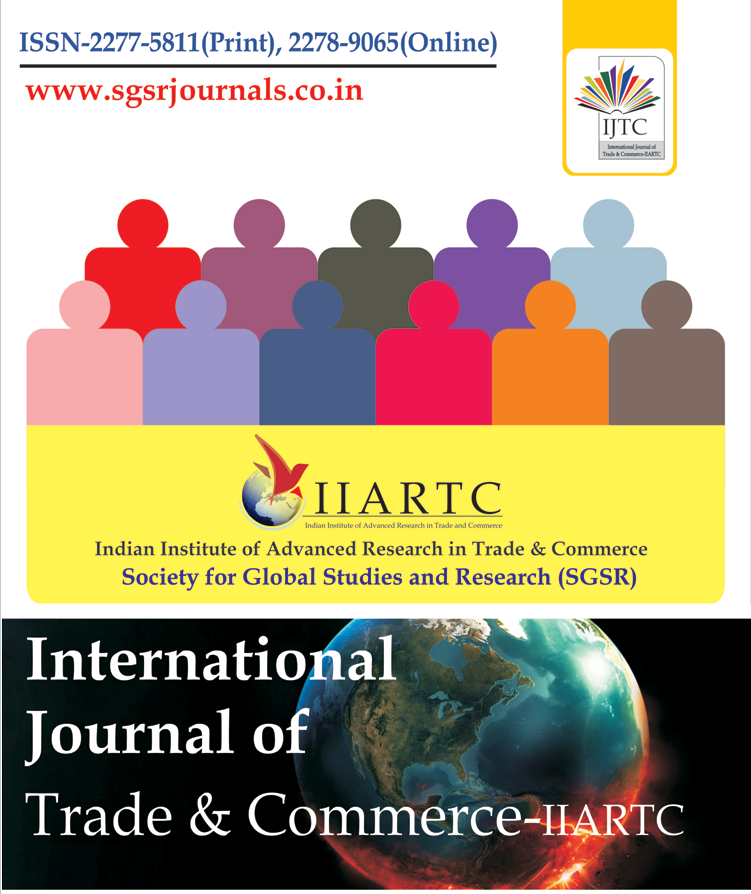Home ⇨ International Journal of Trade & Commerce-IIARTC

International Journal of Trade & Commerce-IIARTC
Impact Factor (IF):5.135 (COSMOS), IF:7.249 (ISRA), IF:3.721 (ISI)
ISSN:2277-5811 (P), ISSN:2278-9065 (O)
Frequency: Half Yearly
Carbon Credit Trading in India
The growing concern about climate change and global warming among world leaders resulted in an international treaty-United Nations Framework Convention on Climate Change (UNFCCC). Kyoto protocol is an international agreement under the UNFCCC with legally binding targets for 37 Developed countries to reduce and limit their Green House Gas emissions by 5.2% below of their emissions on 1990 level. Kyoto (Japan) protocol was adopted in 1997 by the world leaders of Developed countries and till date there are 193 countries that have committed to limiting their greenhouse gas emissions by working together. Emissions trading or cap-and-trade is a market-based approach used to control Green House Gas (GHG) emissions by providing financial incentives to the GHG (CO2) emission reduction projects by reducing use of fossil fuels as well as the rate of forest land conversion. Emission reduction projects like the use of renewable energy for e.g. wind, biomass, small hydro and solar energy projects; waste management that reduces methane emissions, reforestation projects etc can be registered under this market based mechanism to earn carbon credits and sell them. Carbon finance, made available for such projects which are registered under available carbon credit mechanism, facilitates the financial support through carbon credits for the reduction of greenhouse gas emissions to the project developer in developing countries for example India. Emission Trading or Cap & Trade is one of the so called Kyoto Mechanisms under the UNFCCC. In this, the central authority sets a limit of cap on the amount of a pollutant that can be emitted. This limit is sold to the firms in the form of emission permits. An emission permit represents the right to emit the specific volume of a particular pollutant. The Firm would need to hold the number of permits equivalent to their emissions. The number of these permits can not exceed a cap. If a firm wants to increase the emission permits, it would buy from those who need fewer permits. This transfer of permits is called Emission Trade or Carbon Trading. The buyer is paying a charge for polluting, while the seller is being rewarded for having reduced emissions.
Author:Pulkit Agarwala*, Kamlesh Kumarb
Abstract:The growing concern about climate change and global warming among world leaders resulted in an international treaty-United Nations Framework Convention on Climate Change (UNFCCC). Kyoto protocol is an international agreement under the UNFCCC with legally binding targets for 37 Developed countries to reduce and limit their Green House Gas emissions by 5.2% below of their emissions on 1990 level. Kyoto (Japan) protocol was adopted in 1997 by the world leaders of Developed countries and till date there are 193 countries that have committed to limiting their greenhouse gas emissions by working together. Emissions trading or cap-and-trade is a market-based approach used to control Green House Gas (GHG) emissions by providing financial incentives to the GHG (CO2) emission reduction projects by reducing use of fossil fuels as well as the rate of forest land conversion. Emission reduction projects like the use of renewable energy for e.g. wind, biomass, small hydro and solar energy projects; waste management that reduces methane emissions, reforestation projects etc can be registered under this market based mechanism to earn carbon credits and sell them. Carbon finance, made available for such projects which are registered under available carbon credit mechanism, facilitates the financial support through carbon credits for the reduction of greenhouse gas emissions to the project developer in developing countries for example India. Emission Trading or Cap & Trade is one of the so called Kyoto Mechanisms under the UNFCCC. In this, the central authority sets a limit of cap on the amount of a pollutant that can be emitted. This limit is sold to the firms in the form of emission permits. An emission permit represents the right to emit the specific volume of a particular pollutant. The Firm would need to hold the number of permits equivalent to their emissions. The number of these permits can not exceed a cap. If a firm wants to increase the emission permits, it would buy from those who need fewer permits. This transfer of permits is called Emission Trade or Carbon Trading. The buyer is paying a charge for polluting, while the seller is being rewarded for having reduced emissions.




